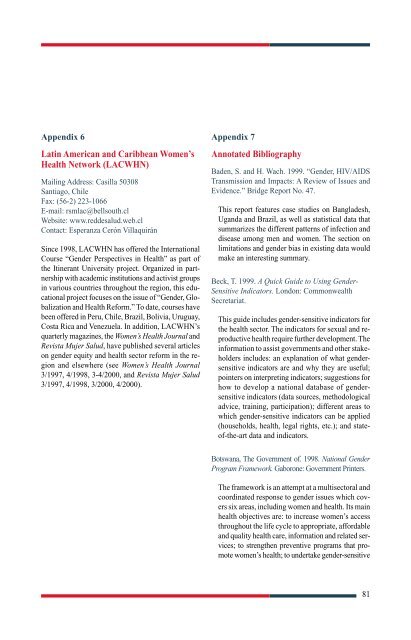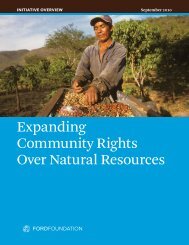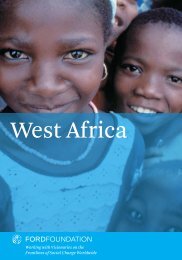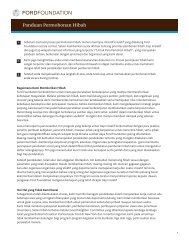Globalization, Health Sector Reform, Gender and ... - Ford Foundation
Globalization, Health Sector Reform, Gender and ... - Ford Foundation
Globalization, Health Sector Reform, Gender and ... - Ford Foundation
- No tags were found...
You also want an ePaper? Increase the reach of your titles
YUMPU automatically turns print PDFs into web optimized ePapers that Google loves.
Appendix 6Latin American <strong>and</strong> Caribbean Women’s<strong>Health</strong> Network (LACWHN)Mailing Address: Casilla 50308Santiago, ChileFax: (56-2) 223-1066E-mail: rsmlac@bellsouth.clWebsite: www.reddesalud.web.clContact: Esperanza Cerón VillaquiránSince 1998, LACWHN has offered the InternationalCourse “<strong>Gender</strong> Perspectives in <strong>Health</strong>” as part ofthe Itinerant University project. Organized in partnershipwith academic institutions <strong>and</strong> activist groupsin various countries throughout the region, this educationalproject focuses on the issue of “<strong>Gender</strong>, <strong>Globalization</strong><strong>and</strong> <strong>Health</strong> <strong>Reform</strong>.” To date, courses havebeen offered in Peru, Chile, Brazil, Bolivia, Uruguay,Costa Rica <strong>and</strong> Venezuela. In addition, LACWHN’squarterly magazines, the Women’s <strong>Health</strong> Journal <strong>and</strong>Revista Mujer Salud, have published several articleson gender equity <strong>and</strong> health sector reform in the region<strong>and</strong> elsewhere (see Women’s <strong>Health</strong> Journal3/1997, 4/1998, 3-4/2000, <strong>and</strong> Revista Mujer Salud3/1997, 4/1998, 3/2000, 4/2000).Appendix 7Annotated BibliographyBaden, S. <strong>and</strong> H. Wach. 1999. “<strong>Gender</strong>, HIV/AIDSTransmission <strong>and</strong> Impacts: A Review of Issues <strong>and</strong>Evidence.” Bridge Report No. 47.This report features case studies on Bangladesh,Ug<strong>and</strong>a <strong>and</strong> Brazil, as well as statistical data thatsummarizes the different patterns of infection <strong>and</strong>disease among men <strong>and</strong> women. The section onlimitations <strong>and</strong> gender bias in existing data wouldmake an interesting summary.Beck, T. 1999. A Quick Guide to Using <strong>Gender</strong>-Sensitive Indicators. London: CommonwealthSecretariat.This guide includes gender-sensitive indicators forthe health sector. The indicators for sexual <strong>and</strong> reproductivehealth require further development. Theinformation to assist governments <strong>and</strong> other stakeholdersincludes: an explanation of what gendersensitiveindicators are <strong>and</strong> why they are useful;pointers on interpreting indicators; suggestions forhow to develop a national database of gendersensitiveindicators (data sources, methodologicaladvice, training, participation); different areas towhich gender-sensitive indicators can be applied(households, health, legal rights, etc.); <strong>and</strong> stateof-the-artdata <strong>and</strong> indicators.Botswana, The Government of. 1998. National <strong>Gender</strong>Program Framework. Gaborone: Government Printers.The framework is an attempt at a multisectoral <strong>and</strong>coordinated response to gender issues which coverssix areas, including women <strong>and</strong> health. Its mainhealth objectives are: to increase women’s accessthroughout the life cycle to appropriate, affordable<strong>and</strong> quality health care, information <strong>and</strong> related services;to strengthen preventive programs that promotewomen’s health; to undertake gender-sensitive81
















